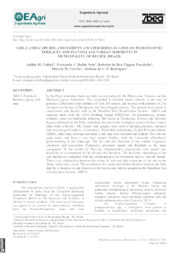Soil-landscape relationship in a watershed located on pleistocenic terraces and fluvio-lagunarian sediments in municipality of Recife, Brazil.
Soil-landscape relationship in a watershed located on pleistocenic terraces and fluvio-lagunarian sediments in municipality of Recife, Brazil.
Autoria: PARAHYBA, R. da B. V.
Resumo: In the Prata watershed there are units corresponding to the Pleistocene Terraces and the Fluvium-Lagoon Sediments. This watershed is inserted almost entirely in the area of plateaus (Tabuleiros) with altitudes of 10 to 100 meters, and in areas with altitudes of 2 to 10 meters in the area of floodplains and fluvio-lagoon terraces. The present work aimed to characterize and classify soils in the Brazilian Soil Classification System - SiBCS and correlate them with the IUSS Working Group WRB-FAO (in parentheses), besides evidence some soil-landscape relations, that occur in Pleistocene terraces and fluvium- lagoon sediments in the Prata watershed, located in the ecological reserve of Dois Irmãos State Park in Recife – PE, Brazil. Soil samples were used to perform physical, chemical and mineralogical analysis in laboratory. Watershed delimitation, Digital Elevation Model (DEM), slope map, soil map and slope x soil map were obtained and studied. The soils are quite acidic and have a very low natural fertility, with the Latossolos (Ferralsols) predominating in the landscape. The silt and clay fractions of the studied Argissolos (Acrisols) and Latossolos (Ferralsols) presented quartz and kaolinite as the main component. In the profile of Neossolo Quartzarênico (Arenosols) only quartz was identified as a component of the silt and clay fractions. The kaolinitic mineralogy of the clay fraction is consistent with the environment of its formation, that is, hot and humid. There is no relationship between the colors of soils and their exposure to the sun on the slopes where they occur. The occurrence of a sandy and whitish horizon between the litter and the A horizon, is not foreseen in the norms and criteria adopted in the Brazilian Soil Classification System - SiBCS.
Ano de publicação: 2023
Tipo de publicação: Artigo de periódico
Unidade: Embrapa Solos
Palavras-chave: Barreiras group, Classificação do Solo, Ferralsolo, Ferralsols, Grupo Barreiras, Mapa, SiBCS, Soil map
Observações
1 - Por padrão são exibidas publicações dos últimos 20 anos. Para encontrar publicações mais antigas, configure o filtro ano de publicação, colocando o ano a partir do qual você deseja encontrar publicações. O filtro está na coluna da esquerda na busca acima.
2 - Para ler algumas publicações da Embrapa (apenas as que estão em formato ePub), é necessário ter, no celular ou computador, um desses softwares gratuitos. Sistemas Android: Google Play Livros; IOS: iBooks; Windows e Linux: software Calibre.
Acesse outras publicações
Acesse a Base de Dados da Pesquisa Agropecuária (BDPA) para consultar o acervo completo das bibliotecas da Embrapa.

